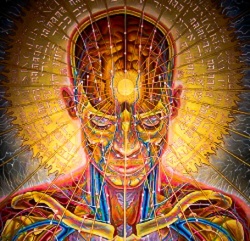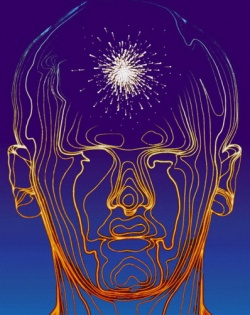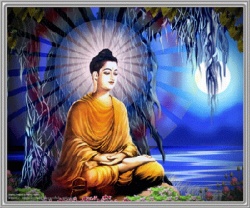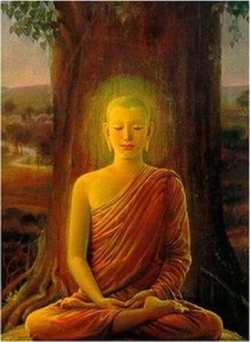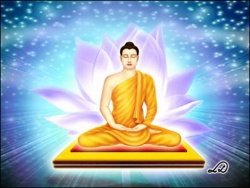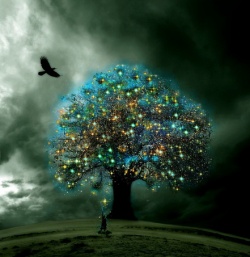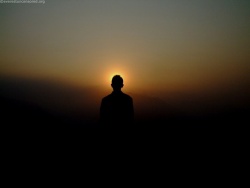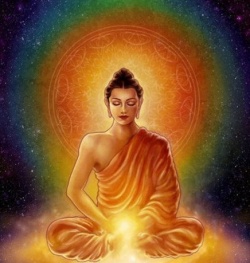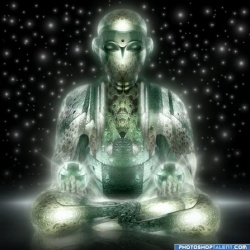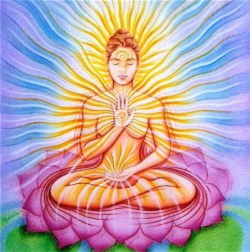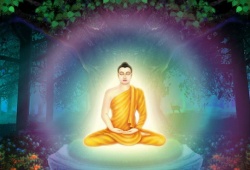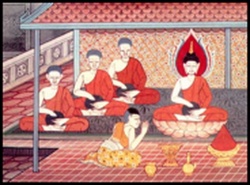Ultimate Reality
Each world religion acknowledges an Ultimate Reality that is eternal and unchanging. There are three fundamental ways in which it is defined: as a personal being (a personal and loving God), as an impersonal being (as origin and target of all personal beings) or as an eternal truth or principle that governs the universe. If the world religions are only parts of a global and unique spirituality, these three perspectives should be consistent with each other. Could they be mere manifestations of the same Ultimate Reality?
The Ultimate Reality in Hinduism
Hinduism is not a unitary religion, but a multitude of religious and philosophical trends. Three main patterns can be identified among them. First, there is henotheism, the religion of the ancient Vedas and later Vaishnavism and Shaivism, which states that many gods exist, but one of them is more important than the others. Second, there is pantheism, the perspective brought by the Upanishads and later Vedanta, which considers Ultimate Reality to be an impersonal transcendent being. Third, there is dualism, the perspective of the Samkhya and the Yoga darshana of Patanjali that acknowledge two ultimate realities. Let's briefly describe them following an approximate chronological order.
The Vedic gods
The oldest sacred scriptures of Hinduism are the four Vedas (Rig, Sama, Yajur, and Atharva Veda). They are four collections of hymns (Samhita) describing deities, their works and the praises that must be addressed to them in religious rituals. Each of the four collections of Vedic hymns is associated with three other kinds of Vedic literature - the Brahmanas, the Aranyakas and the Upanishads. Together they represent the most sacred religious literature (Shruti) of Hinduism. (NB: Remember that throughout the content of this website by "Vedas" we mean only the four collections of hymns, and not the whole corpus of Vedic literature.)
The hymns of the oldest Veda, the Rig Veda, are almost all praises addressed to gods. Among them it seems possible to discern two important generations. The oldest supreme god in the Vedas seems to be [[Wikipedia:Varuna|Varuna]], the sustainer of creation and guardian of universal order. A hymn in the Atharva Veda proclaims:
This earth belongs to Varuna, the King,
and the heavens, whose ends are far apart.
Both the oceans are the loins of Varuna,
and He is merged within the small water drop.
If one will go away beyond the heavens,
still he cannot escape King Varuna;
His envoys move about here from the heavens,
and, thousand-eyed, they look upon the earth. (Atharva Veda 4,16,3-4)
Varuna is omnipotent and omniscient, and deeply involved in human affairs, as he punishes sin and inflicts diseases on those who are guilty of moral transgressions, though humans do not know the specific nature of their transgression. They lament:
O, {{Wiki|Varuna]], what was my chief transgression,
That thou wouldst slay a friend who sings thy praises?
Tell me, god undeceived and sovereign, guiltless
Would I appease thee then with adoration. (Rig Veda 7,86,4)
Punishment must lead to repentance and mending of one’s moral life. In order to avoid punishment people ask for forgiveness of sins:
A hundred are thy remedies, a thousand,
Wide be thy grace and deep, O sovereign ruler;
Far, far away from us drive off Destruction,
And make us free from every sin committed. (Rig Veda 1,24,9)
What appears to be a second generation of Vedic gods has Indra as the most important representative. He takes over all the functions of Varuna after saving mankind from the influence of the demon Vritra, the embodiment of the rough aspects of nature. Vritra had locked the waters in the sky, which caused a catastrophic drought on earth. At the humans' demand, Indra consumed a large quantity of ritual drink (soma), took the lightning (vajra) shaped by the god Tvashtri and, with the help of other gods, killed the demon and brought back the rain on earth (Rig Veda 10,113). That is why he is praised in the hymns:
Adorable Indra, our savior,
Vritra-slayer and furtherer of our highest aims,
May he be our protector from the end,
from the middle, from behind, and from in front.
Lead us to a free world, wise one,
where lie divine luster, sunlight, and security.
Valiant are the arms of thee, the powerful;
we will take to their vast shelter. (Atharva Veda 19,15,1-2)
It is important to notice that although Indra takes over the role of fertility god from Varuna, he fulfills it with much more effort than his predecessor does. Indra depends on the ritual drink soma, and consequently on the sacrifices done by people (which represents a weakness), and has to fight in order to maintain the universal order. His sovereignty over the world is not so striking as it was with Varuna. On the other hand, people appreciate him more than {{Wiki|Varuna]]. They didn't understand {{Wiki|Varuna]]'s ways, but can influence Indra through the sacrifices and therefore get the earthly blessings they seek. Once proclaimed sovereign Lord, Indra takes over the title of maker of the universe, which he doesn't create, but rearranges after his conquest.
Two other gods of this generation, with less important roles in the Vedas, but who will play major roles in later theistic Hinduism, are Rudra (forerunner of Shiva) and Vishnu. Rudra has a dual aspect; on the one hand he is monstrous, murderous and savage; on the other hand he is benevolent, divine healer and protector of cowherds. Vishnu, too, has a minor role in the Vedas, being just one of Indra's helpers in his combat against Vritra and in building the universe. At the same time, he is an intermediary between gods and people, a role that will certainly develop in his later special position.
Along with praising the gods, there are passages in the Vedas that suggest another kind of Ultimate Reality of the universe, beyond the gods we have mentioned. One of the most important Hindu cosmogonies is that of the golden egg (Hiranyagarbha), an entity that was the source of all existing beings and worlds:
At first was neither Being nor Nonbeing.
There was not air nor yet sky beyond.
What was its wrapping? Where? In whose protection?
Was Water there, unfathomable and deep?
There was no death then, nor yet deathlessness;
Of night or day there was not any sign.
The One breathed without breath, by its own impulse.
Other than that was nothing else at all.
Darkness was there, all wrapped around by darkness,
And all was Water indiscriminate. Then
That which was hidden by the void, that One, emerging,
Stirring, through the power of ardor (tapas), came to be. (Rig Veda 10,129)
There are two important aspects to be noticed here:
1) primordial water produced the One; and
2) the whole process was realized by the power of ardor (tapas). This idea is very important because it opens the way towards the notion of One (a primordial matrix that encapsulates all existence) and also toward asceticism, seen as a cosmic creative energy through which the unmanifested becomes manifested. Another important element is the preexistence of an impersonal reality (the One) against personal beings. Gods and men are said to have their origin in this primordial impersonal entity.
Considering an impersonal Ultimate Reality above the gods is a pattern that will dominate most Hindu religious elaboration. The cosmogony of the golden egg is continued in the Brahmana texts in a similar fashion as in the Rig Veda, adding the appearance of a creator (Prajapati) from the golden egg (Shatapatha Br. 11,1,6). Just as the golden egg appears as a result of ardor, this Prajapati created the world using the power released by his ardor. His words are fulfilled as a result of ardor and the material out of which he builds the universe is his own body.
A similar view is presented in the Purushasukta hymn (Rig Veda 10,90), which can be found in a similar version in the Atharva Veda (19,6) and in the Taittiriya Aranyaka (3,12). According to this hymn, the product of the golden egg is the giant Purusha. By his consuming himself in the fire of creation all of the worlds came into existence, including our physical world, the four-caste system, the animals and the duality of the sexes. There is no doubt that Purusha and Prajapati are equivalent, both being produced out of that impersonal One of the Rig Veda 10,129. This passing from a personal Ultimate Reality (represented by the gods) to an impersonal One is an important feature of early Hinduism that will have major implications for later developments.
The Ultimate Reality according to the Upanishads and Vedanta philosophy
Already in the Brahmana writings (Shatapatha Brahmana 6,1,1) it is stated that the whole universe has its origin in non-existence (asat), meaning that existence must be the product of some unmanifested potentialities. This topic is made clear in the Upanishads, which claim that the origin of all existing things is Brahman, the One of the Vedic hymns:
As the spider moves along the thread, as small sparks come forth from the fire, even so from this Self [[[Brahman]]] come forth all breaths, all worlds, all divinities, all beings. (Brihadaranyaka Upanishad 2,1,20)
According to the Upanishads, the Ultimate Reality is Brahman. It (neuter gender) is at the origin of any physical, moral or spiritual activity (see also Brihadaranyaka Up. 4, 1-2; Chandogya Up. 3,18,1-6; Taittiriya Up. 2,6; 3,1). Paradoxically, Brahman has two aspects: immanent, or manifested, and transcendent, or unmanifested. For a better understanding of this concept, we can compare it to the "Big Bang" theory of the origin of the universe. The point of infinite mass out of which all celestial bodies is said to have originated, according to the astronomic theory, has its ideological correspondence with the unmanifested Brahman of Hindu cosmogony. However, in the manifestation of Brahman, the product is not only matter, but also living beings, gods and humans. The cause of the manifestation process is Brahman's desire to be multiplied: "Let me become many, let me be born" (Taittiriya Up. 2,6,1). (However, in a pantheistic context, this is a strange and contradictory idea, because the impersonal being cannot have desires. Probably a more accurate term would have been that of necessity of becoming manifested.) After the manifestation is completed, all its products tend to return to the initial state of unmanifestation, evolving from one level of manifestation to another. Then another manifestation will occur:
As from a blazing fire, sparks of like form issue forth by thousands, even so, O beloved, many kinds of beings issue forth from the immutable and they return thither too. (Mundaka Up. 2,1,1)
Similar to the day and night cycle, the transformation of Brahman between the manifested state and the unmanifested one is everlasting (Kaushitaki Up. 3,3).
The philosophical system (darshana) that follows the pantheistic teachings of the Upanishads is called Vedanta. The most important organizers are Badarayana (4th century AD) and Shankara (9th century AD); the one who conferred to it a pure monistic character as Advaita Vedanta - "the Vedanta of pure monism".
Shankara's vision of the relation of the Absolute with the phenomenal world is reflected in an old Hindu parable, that of the rope mistakenly perceived in the dark as a snake. As the coiled rope in the dark is thought to be a snake, in the same way the empirical world is mistakenly considered to have a distinct existence, independent of the Absolute, through the illusion (maya) produced by ignorance (avidya). As only the rope exists, not the snake, only Brahman has a real existence (sat) and is the true reality. The phenomenal world is real only if perceived as Brahman, as the "reality" of the snake's existence lays in the substratum that produced the confusion, namely the rope. The plurality of the phenomenal world is an illusion (maya), a veil that has to be put aside in order to perceive Brahman. The universe is not unreal, but has the same value as the snake in the parable - it produces confusion and causes humans to pursue a wrong spiritual direction. All that goes beyond this vision of the world is illusion, produced by ignorance.
Shankara tried to settle the relation of the Absolute Brahman (Nirguna Brahman - the One without any definable characteristics) with the origin of the world by proclaiming two distinct points of view: the absolute (paramarthika) and the relative (vyavaharika). In an absolute sense, Brahman is above any duality and external relation; nothing real exists outside him. But from our empirical and relative point of view, Brahman is the cause of the universe we know. In fact there is no real causality; the world is only an illusory sight of Brahman, as with the rope seen as a snake. Brahman's activity in the world and among human beings is nothing but lila, divine play. In conclusion, the Vedanta of Shankara is somehow different from Upanishadic philosophy; the universe is only a phenomenal appearance (vivarta-vada) of Brahman and not his transformation (parinama-vada). From a substantial manifestation, the universe becomes only a dream (or self-forgetting) of Brahman.
The gods of theistic Hinduism
According to the pantheistic view of the Upanishads and Vedanta, the gods are merely inferior manifestations of the supreme impersonal Brahman. However, they continued to play an important role for the average Hindu. The gods that are worshiped today are not the same as in Vedic times. The most important ones became Vishnu and his avatars (especially Rama and Krishna), Shiva and the goddess Kali.
Some pantheist thinkers consider that devotion is nothing but an easier path towards reaching the same impersonal union with the impersonal Ultimate Reality, towards attaining the extinction of personhood, the main source of illusion (maya). Since the adored god is nothing but a form of Brahman, the mystical union with him would be, in this case, nothing more than the same impersonal fusion atman-Brahman. However, the theistic Hindu thinkers strongly disagree with this. They see the personal creator God (Vishnu in Vaishnavism or Shiva in Saivism) as having no preceding origin. Consequently, the One of the Rig Veda, Purusha of the Purushasukta, and Brahman of the Upanishads are considered nothing but the supreme personal God (Vishnu or Shiva). He is both the creator and the substance of the world (as a result of creating the world out of himself), the One that both creates and disintegrates the world at will, and the target of all religious rituals and devotion.
The best known piece of literature representative of Hindu theism is the Bhagavad Gita, where the worshiped god is Krishna, the eighth avatar of Vishnu. In the Bhagavad Gita Krishna is granted a fundamental theological importance. He claims to be eternal (4,6), "the supreme Lord of all planets and demigods" (5,29) and the source of existence: "I am the source of all spiritual and material worlds. Everything emanates from me" (10,8). He is not only the creator but also the substance of the universe (9,16-19; 8,4; 10,20-42). The cycle of permanent transformation between the manifested state and the unmanifested one is characteristic for Krishna too, as it was with Brahman:
At the end of an era (kalpa) all creatures disintegrate into my nature and at the beginning of another era I manifest them again. Such it is my nature (prakriti) to follow again and again the pattern of the Infinite manifestations and disintegrations. (Bhagavad Gita 9,7-8)
The excess of Krishna's superlatives and his identification with the whole of existence grants him a personal portrait that is difficult to grasp. (For more information on this debate on the character of Krishna see our special article on the philosophy of the Bhagavad Gita.) A better Hindu theism will be founded later in time by the great theistic Hindu thinkers Ramanuja (1017 - 1137 AD) and Madhva (1238 - 1317 AD). They rejected the idea that the Ultimate Reality is the impersonal Brahman, who has no attributes, no initiative and no influence on man. As it is impossible to take Brahman as an object of worship, both thinkers accepted the god Vishnu as Ultimate Reality. He is not limited by karma, time, space or any other factor, and has an infinite number of attributes (unlike Nirguna Brahman), the most important being love, absolute knowledge, and compassion. According to Madhva, Vishnu is far from being the impersonal substance of the world. He is a personal god who periodically creates the world out of a primordial substance (prakriti) and dissolutes it at the end of a cosmic cycle. Regarding souls, their creation is periodic and dependent on the karma they acquired in previous existences. However, this means that the act of creation is not totally independent, as an act of God’s sovereign will. Vishnu is not free to create the world at will, but has to do it according to the karma that the souls have accumulated in previous ages, in order that they might work it out and finally attain liberation.
The Ultimate Reality in the Samkhya and Yoga darshanas
Samkhya and Yoga are two of the six Hindu orthodox schools (darshana) developed in the post-Upanishadic period. As most of their metaphysical basis is common, in the absence of any supplementary explanation, what is mentioned here is valid for both schools.
The origin of the Samkhya system is attributed to Kapila (7th century BC), and the real organizer is considered to be Ishvara Krishna (5th century AD). The Yoga system was structured by Patanjali (sometime between 2nd century BC and 3rd century AD), who only systematized the ancient traditions preserved until his time. His masterpiece, in which he formulated the essence of the Yoga system, is the Yoga Sutra.
Samkhya and Yoga are dualistic philosophies, stressing two fundamental notions: purusha (the equivalent of atman) and prakriti (the primordial substance). More will be said about purusha in the next article, where we focus on man's destiny in the two darshanas. Prakriti, the primordial substance, is an impersonal matrix capable of manifestation through transformation. In some way it resembles Brahman through its periodic manifestations. But unlike Brahman, it does not contain the spiritual principle purusha.
The material world is the product of the manifestation of prakriti and has real existence (not illusory, as in Vedanta). Its manifestation is the product of three tendencies inherent in prakriti, called gunas: sattva, rajas and tamas. They are the forces which generate the categories of existence according to which gains dominance over the other two. Sattva is the tendency that brings light, purity and knowledge; rajas is responsible for activity, energy and dynamism; and tamas opposes action, producing darkness, heaviness and ignorance.
The world and individual beings came into existence as a result of the disturbance of the initial state of equilibrium between the three gunas. Any known form in which we see the world manifested is generated by the participation of a certain proportion of the three gunas. The categories of prakriti's manifestation are, in hierarchical order, as follows:
1) mahat, the first product of manifestation, considered to be a mass of pure energy which appeared as a result of the guna sattva domination. Its psychic aspect is the intellect, buddhi.
2) from mahat evolves ahamkara, the principle of individuation (the sense for the "I").
3) after producing ahamkara, the evolutionary process takes two courses of action. Under the influence of the guna sattva, are produced the psychical evolutes: mind (manas), the five cognitive sense organs (sight, hearing, touch, taste and smell) and five associated abilities (speech, movement, prehension, excretion and reproduction). Under the influence of the guna tamas are produced the physical evolutes: the five subtle essences (the essences of color, sound, touch, taste and smell) and the five gross elements, which emerge from the essences (the five fundamental elements in Hindu cosmology - earth, water, air, fire and ether). The guna rajas provides the force required for this manifestation.
Most of the Yoga darshana metaphysics, at it was systematized by Patanjali, comes from Samkhya. It only adds the existence of a divinity, Ishvara. However, this Ishvara is not a personal god, but rather a macro-purusha that was never involved with psycho-mental activity and the law of karma (Yoga Sutra 1,24). We will return to this subject later, in discussing the human relationship with Ishvara as it is stated in the Yoga darshana.
The Ultimate Reality in Tantrism and Hatha Yoga
As a distinct spiritual movement, Tantrism appeared in the 4th century AD. It is possible that it doesn’t have Vedic origin, because its theology is grounded on two deities that did not belong to the Vedic pantheon: Shiva and the Mother Goddess (Shakti), the goddess of land, fertility and life. The two deities became the fundamental terms in which Tantrism developed a pantheistic view of life, Shiva as the transcendental aspect, the pure existence, and Shakti as the immanent and dynamic aspect, through which the phenomenal manifestation occurs.
Hatha Yoga shares the same view on Ultimate Reality with Tantrism. Its forerunner is considered to be Goraknath in the 13th century AD. He and his followers used three sources to ground the new doctrine: Tantrism, devotional Saivism and ascetic practices of the so-called siddhas (the perfect ones). Hatha Yoga reached its full development through Svatmarama (15th century AD), the author of the Hatha Yoga Pradipika treatise. Other important writings are the Gheranda-Samhita and the Shiva-Samhita. They all belong equally to Tantrism.
For both Tantrism and Hatha Yoga, the Ultimate Reality of the universe is the god Shiva. Together with his divine consort Shakti, they form a state of primordial unity and unmanifestation that corresponds in the Advaita Vedanta to Brahman Nirguna, the unmanifested Brahman. The world and the human beings came into existence through the dissociation of the primordial unity of Shiva and Shakti. In the Shiva-Samhita 1,92, it is stated:
Out of the combining of the spirit, that is Shiva, with matter, that is Shakti, and by the interaction of one on the another, all creatures were born.
The same manifestation of the Absolute in creation, as stated by the Upanishads, is presented in the Shiva-Samhita 1,52;69-77.
The Ultimate Reality in Buddhism
The founder of Buddhism, Siddhartha Gautama - the Buddha, lived in the sixth century BC. Two main forms of Buddhism are known today: the conservative branch, represented by the Theravada school, spread mainly in Sri Lanka and southeast Asia, and the liberal branch - Mahayana, spread mainly in China, Tibet, Korea and Japan.
The Theravada school, which claims to have guarded the unaltered message of its founder, teaches that there is neither a personal god, nor a spiritual or material substance that exists by itself as Ultimate Reality. The world as we know it does not have its origin in a primordial being such as Brahman. What we see is only a product of transitory factors of existence, which depend functionally upon each other. The Buddha said:
The world exists because of causal actions, all things are produced by causal actions and all beings are governed and bound by causal actions. They are fixed like the rolling wheel of a cart, fixed by the pin of its axle shaft. (Sutta-Nipata 654)
That gods exist is not rejected, but they are only temporary beings that attained heaven using the same virtues as any human disciple. Gods are not worshiped, do not represent the basis for morality, and are not the givers of happiness. The Ultimate Reality is nothing but a transcendent truth, which governs the universe and human life:
There is grief but none suffering,
There is no doer though there is action.
There is quietude but none tranquil.
There is the path but none walks upon the path. (Buddhaghosa; Visuddhi Magga 16)
Mahayana Buddhism emerged later, between the 1st century BC and the 1st century AD, and was organized by Nagarjuna in the 2nd century AD. Although the texts of Mahayana Buddhism claim to be a recollection of early speeches of the Buddha, they contradict some conservative doctrines of the Theravada school. It is said that the Mahayana sutras were revealed many years after the master's death, because at that time the world was not yet able to understand them. According to their teaching, Ultimate Reality is also an ultimate truth, called the truth of emptiness. Emptiness is a quality attached to any physical, mental or doctrinal concept. It is the basis of our world, not as a substance, but as a truth. The doctrine of emptiness denies any kind of substantial ultimate reality and affirms that the world is to be seen as a web of interdependent and baseless phenomena.
The presence of many Buddhas in Mahayana Buddhism inaugurated a strong devotional trend that had to be reconciled with this doctrine of emptiness. The result was the doctrine of the three bodies of the Buddha (Trikaya), developed by the Yogachara school in the fifth century AD. It says that Ultimate Reality, called Buddhahood, is expressed at three levels of understanding. The first is Dharmakaya, the essential body of the Buddha, representing emptiness itself. It is the ultimate truth that governs the world. The other two bodies are the embodiment of compassion for beings ensnared by illusion. It is only because ignorance blinds conditioned beings, that the Dharmakaya is manifested as the other two, so that the conditioned beings can grow in wisdom and eventually attain enlightenment.
The second body is the Samboghakaya, the body of enjoyment. It is the body of the Buddhas in their Pure Lands, where they preach the Mahayana doctrine to those reborn here. The Buddhas in this form are the objects of Mahayana devotion, the source of grace for the devotees of popular Buddhism.
What was known as the physical body of Siddhartha Gautama is the third body of the Buddha, the Nirmanakaya. It is a mere image manifested in our world for the benefit of the lowliest of beings, the most ignorant and weak, unable to attain a Pure Land.
Mahayana takes a different stand on the person of Siddhartha Gautama. According to the traditional view he was a physical being, the founder of the four noble truths and the first human that reached nirvana. In Mahayana Buddhism he is considered to be only one of many Buddhas, the compassionate beings that help other humans to find liberation.
Ultimate Reality in Taoism and Confucianism
Taoism states an impersonal Ultimate Reality that is both the creator principle and the eternal truth of universe. It is the Tao, the immutable and unchanging principle that is the basis of multiplicity and the impulse that generates all forms of life. The founder of Taoism, Lao Tse (6th century BC), stated in his important writing, Tao-te Ching:
There was something undifferentiated and yet complete,
Which existed before heaven and earth.
Soundless and formless, it depends on nothing and does not change.
It operates everywhere and is free from danger.
It may be considered the mother of the universe.
I do not know its name; I call it Tao. (Tao-te Ching 25)
In the same way as the Hindu Brahman or Buddhist Dharmakaya, Tao is the source in which all the manifestations of the world originate and return:
All the flourishing things
Will return to their source.
This return is peaceful;
It is the flow of nature,
An eternal decay and renewal. (Tao-te Ching 16)
Tao holds two complementary and opposite modalities that are present in creation: Yin and Yang (Yin - the female principle of darkness, potentiality, regression; and Yang - the male principle of light, activity and progress). Their dynamic and the proportions in which they become mixed at a certain moment determine all aspects of nature or living beings: from day and night, life and death, to personal feelings and dispositions. Any personal form of existence, gods and humans alike, receive their wisdom from Tao, being merely temporary forms of its manifestation:
[[[Tao]]] is its own source, its own root. Before heaven and earth existed it was there, firm from ancient times. It gave spirituality to the spirits and gods; it gave birth to heaven and to earth. (Chuang Tzu 6)
The existence of Taoist divinities is the result of an attempt to combine devotion to the ancient Chinese gods with classic Taoism, as a way of making it more acceptable to lay people. Deities like the Jade Emperor (Yu-huang) and The First Principal (Yuan-shis Tien-Tsun) are considered in some traditions to be gods, while other deities like the three Pure Ones (San-ch’ing) are more like Buddhist bodhisattvas, acting as manifestations of Lao Tse.
Another important Chinese religion is Confucianism. Rather than a religion, Confucius (6th century BC) founded an ethical system in order to harmonize social relations in the Chinese state. For this reason it is hard to say that Confucianism, at least in its original form, is a true religion. Although Confucius respected the religious traditions of his time, he gave them a mere ethical interpretation. The supreme principle in the universe according to him is the moral law, a universal principle, omnipresent, hidden and eternal:
There is no place in the highest heavens above or in the deepest waters below where the moral law is not to be found. (Doctrine of the Mean 12)
Following the moral principles means to conform oneself to the will of heaven, but more metaphysical speculations about heaven and afterlife are useless (Analects 7,20).
Ultimate Reality according to the three major monotheistic religions - Judaism, [[Wikipedia:Christianity|Christianity]] and Islam
Judaism, the earliest monotheistic religion, is about the personal God who revealed himself through the story of the Jewish people. We find it in the scriptures called the Torah by the Jews and the Old Testament by the Christians.
In the very beginning of the Old Testament, God is presented creating the universe out of nothing (ex nihilo) and does not manifest it out of his own substance as Brahman, or out of a preexistent matter as Indra does. This "nothing" has no ontological statute, it is not a primordial substance, because prior to creation nothing existed except God. The Psalms state:
In the beginning you laid the foundations of the earth, and the heavens are the work of your hands. They will perish, but you remain; they will all wear out like a garment. Like clothing you will change them and they will be discarded. But you remain the same, and your years will never end. (Psalm 102,25-27)
The creation presented in the book of Genesis is an act intended and completed by the creator, not out of necessity, but out of love. The beginning or cause of the world is not an impersonal necessity or a blind manifestation of an undetermined nature, but the product of the free choice of a personal God. Being consequent to the idea of the fundamental unity of the world in Brahman, pantheism has to consider the physical world and humans as manifestations of Brahman, manifestations of the same primordial essence to which they are destined to return. For this reason, it can be said that the impersonal Absolute is incomplete without his "creation", i.e., without the manifestation of his potentiality. The manifestation of Brahman is a necessity derived from its very nature. In pantheism creation is always a transformation (or manifestation) of a primordial impersonal unity. It is not a replacement of "nothingness" with "something", but a transformation of the ultimate reality from one ontological condition into another. What once existed in unity becomes multiplicity and manifestation. Therefore the nature of ultimate reality and that of creation prove to be quite different in the monotheist perspective.
The personal and triune God of [[Wikipedia:Christianity|Christianity]]
According to [[Wikipedia:Christianity|Christianity]], God reveals himself to be personal and triune. He exists as God the Father, God the Son and God the Holy Spirit, without beginning and without having his origin in a primordial impersonal essence.
There are some important points to make clear about the origin and meaning of the term "person" (Latin persona, Greek prosopon). Initially used in the Greek ancient theater for the actors’ mask, the term designated in Hellenistic philosophy "the masked face of the impersonal being". The term used for the impersonal essence of reality was ousia, and its determined, singular forms were called hypostases. If Christian theology had been only a form of Hellenistic philosophy, it should have said that the hypostases - Father, Son and Holy Spirit - are mere functional aspects of the divine nature ousia. The novelty brought by Christian theology is the fact that each person of the Holy Trinity has the fullness of divine nature, and the ontological character of the Ultimate Reality is defined by the reality and relation that exists between the three hypostases. A major contribution in defining this aspect was made by the Cappadocian fathers of the Church (Basil the Great, Gregory of Nyssa and Gregory of Nazianzus).
Therefore the Holy Trinity should be understood neither as a sum of three Gods (tri-theism), nor as a mono-personal God that assumes successively three distinct forms (the modalistic heresy). God’s being does not exist outside the three persons, but only as Father, Son and Holy Spirit, and they are the only way for God's existence. So there cannot exist an Ultimate Reality "beyond" or "above" the Holy Trinity, as in pantheism (Brahman as the ultimate nature of the gods). Therefore none of the three hypostases, Father, Son or Holy Spirit, can be considered a kind of Hindu Ishvara, a first manifestation of the impersonal Brahman. Christian theology overthrew the values of Hellenistic metaphysics in order to adapt its terms to the newly revealed reality. In defining divinity, the accent must be transferred from an impersonal Ultimate Reality to the personal character of the Holy Trinity and the relation between the three hypostases. Here is the origin of the term "divine person" (from the Latin persona), and (derived from it) the term "human person".
The triune God exists by himself. In his revelation to Moses, he called himself "I am who I am" (Exodus 3,14). This means that he is self-sufficient, that he does not depend on any exterior element. His existence is expressed through love, omnipotence and omniscience, among which there is perfect unity and harmony. None is manifesting itself by infringing on the other because the Holy Trinity is perfect in love, will and deed. Associated with these characteristics are justice and immutability. God’s immutability is not a reminder of Brahman Nirguna's immobility, but an absolute stability in truth and goodness. Likewise, when the Apostle John proclaims that "God is love" (1 John 4,8) this should not be interpreted as an expression of the impersonal primordial energy, but as form of expressing the supreme unity of the tri-personal communion. It doesn't just mean that God has love, as a quality, but that he is love, which is the way of being in the Trinity, each person existing not for himself, but for the others, in a perfect communion of love.
(One can use the following links for more information on the concept of the Holy Trinity:
Gregory of Nyssa, On the Holy Trinity, and of the Godhead of the Holy Spirit; On "Not Three Gods"; Early Christians on the Trinity)
The God of the Bible admits no deeper Ultimate Reality beyond himself. He is not an Ishvara manifested out of Brahman (or a Deus manifested out of Deitas, according to Eckhart), a god that comes and goes, located far beyond the impersonal absolute. The triune God of Christianity does not admit the existence of a "deeper reality" in which he originated, because he says:
I am the first and I am the last; apart from me there is no God (Isaiah 44,6).
He cannot be equated with any god of the Hindu pantheon. They are only aspects of an impersonal Absolute, manifestations that will finally be absorbed by it. The triune God of Christianity is different from Krishna, who periodically manifests and annihilates the universe (Bhagavad Gita 9,7-9). According to Christianity, God does not create the same world many times, but just once, and then not out of any necessity that surpasses him. Neither can he be equated with the "Hindu trinity" Brahma (the creator), Vishnu (the preserver) and Shiva (the destroyer). The three Hindu gods are reminiscences of the old Vedic polytheism, from where they have been later assimilated as primary products of Brahman's manifestations. As a consequence, it is absurd to define a superior and esoteric way (apara-vidya), that aims at the impersonal Absolute, and an inferior exoteric way (para-vidya) for those who are so limited that they are satisfied with a personal manifestation of the absolute. [[Wikipedia:Christianity|Christianity]] cannot be assimilated as a form of bhakti-yoga, a way accessible for the inferior and weak people to attain the impersonal Ultimate Reality of the world.
God and creation in Islam
The other great monotheistic religion of the world, Islam, was founded by the prophet Muhammad at the beginning of the sixth century AD. The god of Islam, Allah, is presented in the Quran as an eternal being, transcendent and almighty. In the 112th Surah it is stated:
Say, He is God, the One!
God, the eternally Besought of all!
He neither begets nor was begotten.
And there is none comparable unto Him.
Allah seems to have the same attributes as God the Father of the Old Testament, since the influence of the Old Testament on the Quran is more than probable. For more information on this topic one can follow these links:
"The Bible and the Quran" - An Historical Comparison (manuscript, documentary and archaeological analysis)
"The Textual history of the Quran and the Bible", by John Gilchrist.
The Triune God of Christianity is considered to be a heresy, both in Judaism and Islam, a threat to monotheism. Therefore, Allah cannot be the same as God the Father of the Christian Trinity, since Allah says that belief in the Trinity is one of the worst possible heresies and sins:
Surely, unbelievers are those who said, "Allah is the third of the three [in a Trinity]". But there is no god but One God. And if they cease not from what they say, verily, a painful torment will befall the unbelievers among them (Quran 5,73).
Conclusion
The world's religions hold very different views on Ultimate Reality. More than merely different, they are irreconcilable one with another. Indeed, the impersonal Brahman of the Upanishads, who balances between his manifested state and unmanifestation, or the lack of any transcendental being, as stated by Theravada Buddhism, are positions that cannot be reconciled with the personal God of the monotheistic religions. In fact, we can witness irreconcilable positions even among the many branches of Hinduism (remember the gods of the Vedas, the Brahman of Vedanta, Vishnu of the theistic movements founded by Ramanuja and Madhva, and Ishvara of the Yoga darshana). On the other hand, even the three great monotheistic religions of the world state irreconcilable positions concerning the nature of the personal God. He must be either tri-personal (the triune God of [[Wikipedia:Christianity|Christianity]]), or mono-personal (as in Judaism and Islam).

